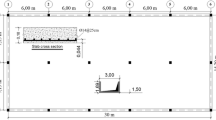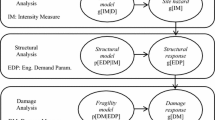Abstract
Contemporary societal concerns emphasize the importance of cost optimization and sustainable constructions. However, with respect to structural fire safety, the application of prescriptive design rules remains common practice and optimization procedures are generally limited to a few examples of performance based design. Both methods consider an explicit or implicit prescribed safety level which is based on societal and empirical considerations. A more rational approach is to take into account the characteristics of the structure and to determine the economic optimum fire safety design. This economic optimum is obtained by minimizing the total costs, explicitly taking into account e.g. the fire ignition frequency, the probability of successful fire suppression and the damage costs due to a fire-induced failure. Applying this methodology to the design of simply supported concrete slabs indicates that in specific situations additional investments beyond the legally required minima constitute a more cost-effective design. It is concluded that the cost optimization of structural fire safety is a powerful tool to assess the utility of additional safety investments beyond the legal requirements.









Similar content being viewed by others
Abbreviations
- As :
-
Bottom reinforcement area (mm2/m)
- As,ref :
-
Reference reinforcement area corresponding with cref (mm2/m)
- B(p):
-
Lifetime utility derived from the structure’s existence (Eur)
- C(p):
-
Total construction cost (Eur)
- C*(p):
-
Cost due to a single structural failure (Eur)
- C0 :
-
Construction cost independent of p (Eur)
- C1(p):
-
Construction cost dependent on p (Eur)
- D(p):
-
Lifetime cost due to structural failures (Eur)
- MEd :
-
Design value of the bending moment induced by the design loads for normal design conditions (kNm)
- MG :
-
Bending moment induced by the permanent loads (kNm)
- MGk :
-
Characteristic value of MG (kNm)
- MQ :
-
Bending moment induced by the variable loads (kNm)
- MQk :
-
Characteristic value of MQ (kNm)
- MR,fi,t :
-
Bending moment capacity during fire at t minutes of exposure to the ISO 834 fire (kNm)
- MRd :
-
Design value of the bending moment capacity for normal design conditions (kNm)
- Pf,fi,t :
-
Probability of failure at t minutes of exposure to the ISO 834 fire (–)
- Pf,tE :
-
Probability of failure at tE minutes of exposure to the ISO 834 fire (–)
- R:
-
Structural fire resistance time classification as defined by the Construction Products Regulation (min)
- Z(p):
-
Lifetime utility function (Eur)
- a:
-
Cost of reinforcement per additional mm2 of reinforcement area (Eur/mm2)
- b:
-
Benefit rate (Eur/year)
- c:
-
Nominal concrete cover (mm)
- cm :
-
Probabilistic model of the concrete cover
- cref :
-
Reference concrete cover of 15 mm
- f1(t,p):
-
Probability density function describing the time to the first structural failure
- fn(t,p):
-
Probability density function of the time to the nth structural failure
- f*(γ,p):
-
Laplace transform of f1
- fTig :
-
Probability density function of the time between fire ignitions
- fTig,k :
-
Probability density function of the time to the kth fire ignition
- p:
-
Design parameter
- p1 :
-
Annual fire ignition frequency (1/year) (equal to λ)
- psup :
-
Probability of successful fire suppression (–)
- s:
-
Horizontal spacing of the reinforcement bars (mm)
- tE :
-
Duration of the ISO 834 standard fire (min)
- βfi,t :
-
Reliability index at t minutes of exposure to the ISO 834 fire (–)
- γ:
-
Continuous discount rate (1/year)
- ε(p):
-
Ratio of C1(p) to C0 (–)
- λ:
-
Fire ignition frequency (1/year)
- λ*:
-
Fully-developed fire frequency (1/year) (equal to (1 − psup)λ)
- λf,fi :
-
Fire-induced structural failure frequency (1/year) (equal to Pf,tE λ*)
- ξ:
-
Ratio of the costs due to a single failure to the initial construction costs (–) (C*(p)/C(p))
- χ:
-
Load ratio (–) (MQk/(MQk + MGk))
References
Ceranic B, Fryer C (2000) Sensitivity analysis and optimum design curves for the minimum cost design of singly and doubly reinforced concrete beams. Struct Multidiscipl Optim 20:260–268
Kanagasudaram S, Karihaloo BL (1990) Minimum cost design of reinforced concrete structures. Struct Optim 2:173–184
Barros AFM, Barros MHFM, Ferreira CC (2012) Optimal design of rectangular RC section for ultimate bending strength. Struct Multidiscipl Optim 45:845–860
Han SH, Adamu A, Karihaloo BL (1996) Minimum cost design of multispan partially prestressed concrete T-beams using DCOC. Struct Optim 12:75–86
Kanda J, Shah H (1997) Engineering role in failure cost evaluation for buildings. Struct Saf 19:79–90
Elms DG (1997) Risk balancing in structural problems. Struct Saf 19:67–77
Cohen L, Noll R (1981) The economics of building codes to resist seismic shocks. Public Policy 29:1–29
Kunreuther H (2001) Incentives for mitigation investment and more effective risk management: the need for public–private partnerships. J Hazard Mater 86:171–185
Rosenblueth E, Mendoza E (1971) Reliability optimization in isostatic structures. J Eng Mech Div 97:1625–1642
Rackwitz R (2000) Optimization—the basis of code-making and reliability verification. Struct Saf 22:27–60
Rackwitz R (2001) Optimizing systematically renewed structures. Reliab Eng Syst Saf 73:269–280
Rackwitz R (2002) Optimization and risk acceptability based on the life quality index. Struct Saf 24:297–331
Rackwitz R, Lentz A, Faber M (2005) Socio-economically sustainable civil engineering infrastructures by optimization. Struct Saf 27:187–229
Graubner C-A, Brehm E, Glowienka S (2007) Economic potentials of probabilistic optimization methods. In: Proceedings of the 5th international probabilistic workshop, Ghent (28-29/11), pp 219–231
Lentz A (2007) Acceptability of civil engineering decisions involving human consequences. Doctoral thesis, Technical University of Munich
Cornell M, Daniels P, Kirkland J, Wolff A (1976) A survey of methods for estimating the cost value of a human life. Report No. CG-D-66-76, US Coast Guard. http://hdl.handle.net/2027/ien.35556021299177
Nathwani JS, Lind NC, Pandey MD (1997) Affordable safety by choice: the life quality method. Institute for Risk Research, University of Waterloo, Waterloo
Proske D (2008) Catalogue of risks: natural, technical, social and health risks. Springer, Berlin
Adey B, Hajdin R, Brühwiler E (2004) Effect of common cause failures on indirect costs. J Bridge Eng 9:200–208
Van Coile R, Caspeele R, Taerwe L (2012) Global resistance factor for concrete slabs exposed to fire. In: Proceedings of the 7th international conference on structures in fire, Zürich (6-8/6), pp 775–784
Eamon CD, Jensen E (2012) Reliability analysis of prestressed concrete beams exposed to fire. Eng Struct 43:69–77
Sidibé K, Duprat F, Pinglot M, Bourret B (2000) Fire safety of reinforced concrete columns. ACI Struct J 97(10):642–647
CEN (2002) EN 1990: basis of structural design. European Standard
CEN (2004) EN 1992-1-1: design of concrete structures: part 1-1: general rules and rules for buildings. European Standard
NBN (2010) NBN EN 1992-1-1-ANB: Eurocode 2: ontwerp en berekening van betonconstructies—Deel 1-1: algemene regels en regels voor gebouwen. Belgian National Annex to EN 1991-1-1
Holický M, Sýkora M (2010) Stochastic models in analysis of structural reliability. In: Proceedings of the international symposium on stochastic models in reliability engineering, life sciences and operation management, Beer Sheva (08-11/02)
JCSS (2001) Probabilistic model code. The Joint Committee on Structural Safety. www.jcss.byg.dtu.dk
CEN (2004) CEN, EN 1992-1-2: design of concrete structures: part 1-2: structural fire design. European Standard
Annerel E (2010) Assessment of the residual strength of concrete structures after fire exposure. Doctoral thesis, Ghent University, Ghent
Holický M, Retief JV, Dunaiski PE (2007) The reliability basis of design for structural resistance. In: Proceedings of the third international conference on structural engineering, mechanics and computation (SEMC), Cape Town
Gulvanessian H, Calgaro J-A, Holický M (2002) Designers’ guide to EN 1990: Eurocode 0: basis for structural design. Thomas Telford, London
Torrent RJ (1978) The log-normal distribution: a better fitness for the results of mechanical testing of materials. Matér Constr 11:235–245
Van Coile R, Caspeele R, Taerwe L (2012) Quantifying the structural safety of concrete slabs subjected to the ISO 834 standard fire curve using full-probabilistic FEM. In: Proceedings of the 10th international probabilistic workshop, Stuttgart (15-16/11), pp 313–330
European Union (2011) Regulation (EU) No 305/2011 laying down harmonized conditions for the marketing of construction products and repealing Council Directive 89/106/EC. Off J Eur Union 54(88):5–43
Ang AH-S, Tang WH (2007) Probability concepts in engineering, 2nd edn. Wiley, New York
Albrecht C, Hosser D (2010) Risk-informed framework for performance-based structural fire protection according to the Eurocode fire parts. In: Proceedings of the 12th interflam conference, Nottingham (5-7/07), pp 1031–1042
Rahikainen J, Keski-Rahkonen O (2004) Statistical determination of ignition frequency of structural fires in different premises in Finland. Fire Technol 40:335–353
Sandberg M (2004) Statistical determination of ignition frequency. Master Dissertation, Lund University, Sweden
Sleich J-B, Cajor L-G, Pierre M, Joyeux D, Aurtenetxe G, Unanua J, Pustorino S, Heise F-J, Salomon R, Twilt L, Van Oerle J (2002) Competitive steel buildings through natural fire safety concepts—final report. European Communities, London
Fontana M, Favre JP, Fetz C (1999) A survey of 40000 building fires in Switzerland. Fire Saf J 32:137–158
Belgisch Staatsblad (1994) Koninklijk Besluit tot vaststelling van de basisnormen voor de preventie van brand en ontploffing waaraan nieuwe gebouwen moeten voldoen, Belgisch Staatsblad, 26/05/1995, p 11036
National Building Specification (2013) Approved document B—fire safety, vol 2. Buildings other than dwelling houses
Bouwbesluit (2012) Staatsblad van het Koninkrijk der Nederlanden, p 416
Holický M (2009) Probabilistic risk optimization of road tunnels. Struct Saf 31:260–266
Holický M (2013) Optimisation of the target reliability for temporary structures. Civil Eng Environ Syst 30:87–96. doi:10.1080/10286608.2012.733373
Acknowledgments
The authors wish to thank the FWO for the financial support on the research project “Probabilistic formulation of the structural reliability of concrete structures subjected to fire in relation to risk-based decision making and risk-transfer mechanisms”.
Author information
Authors and Affiliations
Corresponding author
Rights and permissions
About this article
Cite this article
Van Coile, R., Caspeele, R. & Taerwe, L. Lifetime Cost Optimization for the Structural Fire Resistance of Concrete Slabs. Fire Technol 50, 1201–1227 (2014). https://doi.org/10.1007/s10694-013-0350-9
Received:
Accepted:
Published:
Issue Date:
DOI: https://doi.org/10.1007/s10694-013-0350-9




